 |
"Our Home in Fiji
" (Frontispiece)
The picture is of the Government House
location at Nasova, Levuka. The Cyclopedia of Fiji recorded,
"To see Levuka properly - and half an hour would be sufficient
to do it completely - it was necessary to start from the extreme
south end, that is from Government
House, Nasova where Sir Arthur Gordon
resided. It was a wooden, veradahed building, with thached roof.
The main part of the building looked seaward, and two wings,
one at each end, jutted out at right angles toward the sea. There
were no other hoses - with the exception of the "vales"
[vale (vah-leh) = Fijian house] in which the native soldiers
lived, in proximity to it. It thus stood isolated as regards
Levuka, and, though different to most Government Houses, it was
an eligible residence in appearance and dimensions" (p.126)
|
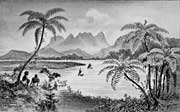 |
"On the Upper
Rewa [River: Na Wailevu]. Foreground of Tree-Ferns" (p.86)
|
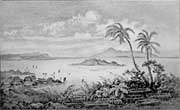 |
"Isles of Ovalau,
Moturiki, Bau and Viwa. From Viti Levu" (p.110).
This is a very foreshortened impression,
which makes the islands appear close inshore. In fact, Ovalau
is a considerable distance from the mainland.
|
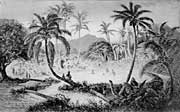 |
"Hot Springs, Isle
Gau" (p.180)
The springs are still in use in Gau
for bathing, as illustrated here. They are warm rather than hot,
unlike the springs in SavuSavu, Vanualevu, which are hot enough
to cook yams and taro in.
|
 |
"A Chief's kitchen"
(p.208)
The illustration actually shows the
interior of the chief's large dwelling. It is unlikely there
would be quite this assemblage of objects in one home, but it
allowed the artist to display a tour-de-force of material culture
illustration, as elaborated in the full
picture. The cooking hearth was traditionally
in one end of this, as shown here.The rack over the hearth was
a useful place for storage, not only of pots, as here, but also
(wrapped in a protective old mat, or placed out of the direct
path of the smoke) mats and bark-cloth (as here), which the smoke
proofed against insect and vermin attack. (Apropos vermin, note
the rats eating scraps in the foreground). The smoke also protected
the rafters and thatch from insect attack - a fatal problem ever
since the colonial government insisted on the removal of kitchens
to a separate building, which has contributed greatly to traditional
thatched buildings being abandoned throughout Fiji in favour
of ugly and uncomfortable wood, concrete and corrugated iron
buildings.
|
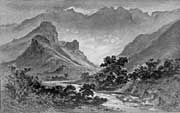 |
"The Kauvandra Mountains" (p.252)
The mountain area called Nakauvadra
(meaning literally, the "screw-pine" or "pandanus"
tree) in north-central Vitilevu is a rugged and inhospitable
region with the highest mountains in Fiji. The Scot Gordon Cumming
was very impressed with this rugged place, writing, "Another
day filled with impressions of beauty. Few bits of Scotland can
compare with the mountain scenery of these isles. I only wish
it were possible to make expeditions inland, and explore the
dark ravines and corries which seam the great mountain-range
of the Kauvandra, along the base of which we have been riding
all day" (At Home in Fiji p.251-2)
It was a beauty and mystery not lost
on the Fijians, who believed this to be home to the principal
god in their pantheon, Degei, adopting the form of a giant python
[Pacific boa] living in a cave. His children were believed to
have spread out through Fiji and many oral traditions trace lineages
back through them to this region. When asking a Fijian where
their clan's utimate origin-place (yavutu) is, the most
common answer in Fiji is "Nakauvadra".
|
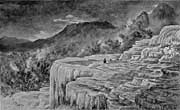 |
"The White Terraces,
New Zealand" (p.294)
The extraordinary geological
features of the Pink and White Terraces
near Rororua were New Zealand's premier tourist attraction, together
claimed as the eighth wonder of the world. The White Terraces
fell 30 metres from a geyser that produced the white silica of
the terraces. However on 10th June 1886, at 3:00 am, it was obliterated
by New Zealand's most violent recorded volcanic eruption, that
of Mount Tarawera, which covered it in lava. A second eruption
several hours later, through the bed of Lake Rotomahana, buried
the Maori villages of Moura and Te Ariki under a mud, stones
and ash. Some excavation of the villages has occurred in recent
years and the site may be visited, but the terraces have been
lost forever.
|













